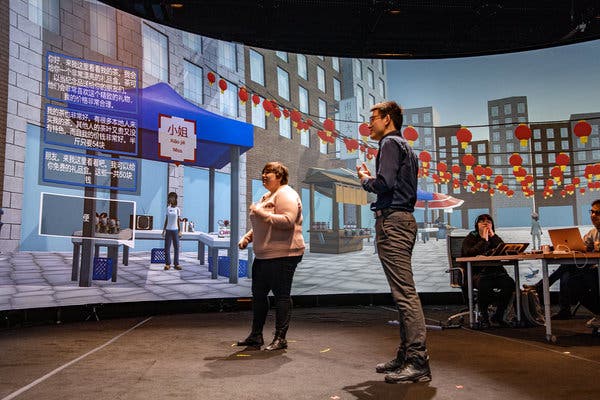Find all our Lessons of the Day here.
Featured Article: “How Technology Is Changing the Future of Higher Education” by Jon Marcus.
Labs across the country are testing artificial intelligence, virtual reality and other innovations that could improve learning and lower costs for Generation Z and beyond.
In this lesson, you will learn how they are trying to solve problems in higher education with solutions that sound straight out of a science-fiction novel. Then, you’ll come up with creative ideas of your own for improving your schooling experience.
Imagine you have the opportunity to join a team of innovators to shape the future of education. Your job is to dream up what school could look like in five, 10 or 50 years from now.
To do this, you’ll follow the process of design thinking:
Step 1: Empathize. What do students need? Make a list of all the things that help young people learn and set them up for success. And try to think beyond your own needs. What could be helpful for people of all backgrounds, places and abilities?
Step 2: Define. Next, you’ll have to define the problems in the current system that might prevent students from being successful in school. These might have to do with the structure of school. For example, some students might have a hard time just getting to the building every day or learning in a classroom with 30 other students. Or, you might identify problems with the curriculum, expectations or anything else. Make a list of at least three that you think are important.
Now, you’ll read an article about how one organization is trying to come up with creative solutions for how to solve problems like these in higher education.
Read the article, then answer the following questions:
1. What is the Sandbox ColLABorative? How does it imagine the future of education?
2. What does the current structure of higher education look like? Why do innovators see a need to disrupt that system?
3. William Zemp, chief strategy and innovation officer at Southern New Hampshire University, says one of the most important things the Sandbox ColLABorative does is “disprove and dismantle ideas.” What does he mean by this? Why do you think it’s so important to the work?
4. What problem does the “college by subscription” model aim to solve? How does the proposed model address this problem?
5. How might a virtual teaching assistant improve students’ educational experiences? What gaps in the current system is it trying to fill?
6. What are the issues with traditional academic transcripts? How is the “interoperable learning record” trying to address them?
7. Which of the innovations mentioned in the article are most intriguing to you? Why? Could you see potential challenges with adopting any of them?
Now that you’ve read about some of the ways innovators are trying to solve problems in higher education, you’ll continue the process of design thinking to come up with some of your own:
Step 3: Ideate. This is the fun part. What creative, out-of-the-box solutions can you come up with to solve the problems you identified at the beginning of this lesson? What would your ideal schooling experience look like? How could you restructure the school day, reimagine the curriculum or use virtual reality, artificial intelligence or even technology that hasn’t been invented yet to improve education? Brainstorm a list of as many ideas as you can think of, no matter how impossible they may seem.
Steps 4-5: Prototype and Test. If you have time, you might imagine how you could produce a scaled-down version of one of these ideas. What steps would you take to test it out with real students? How might your proposal make education better for everyone? What potential challenges might you encounter when putting it into effect?








